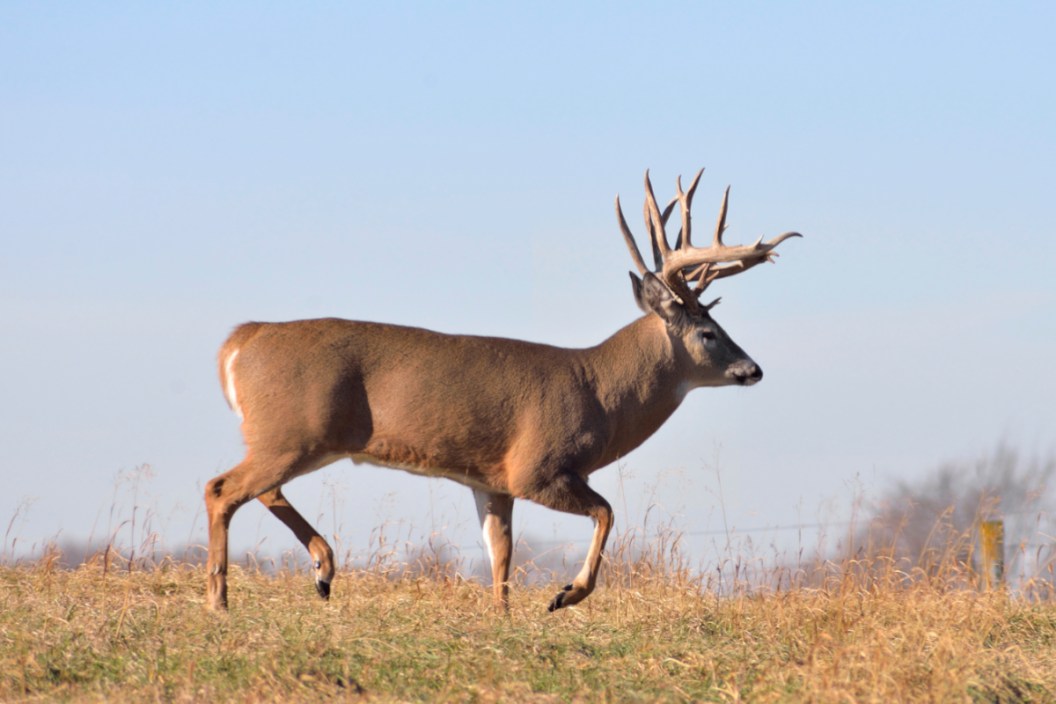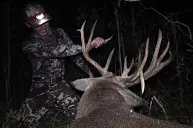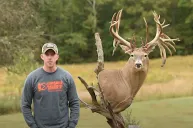"Oh no, you shot Grayface!" That was the reaction of two hunters to an old 10-pointer my dad shot during the 1999 deer season. We learned from these hunters they had been watching this buck, who they named for his unusually gray muzzle, all season. The thing that amazed us was the spot they'd been observing the deer was six or seven miles from where my dad eventually shot him! This wasn't an isolated incident in our hunting area. In 2013, we encountered another stranger when I downed a gnarly 10-pointer that had made no previous trail camera appearances, nor had my uncle seen him during the bow season. Four years later it happened again when my uncle shot a buck he'd never seen before, and my trail cameras had not captured even once. Roughly a month after that harvest, we were sent photos of the buck that had been taken by another hunter's camera six or seven miles away from where my uncle shot him.
All these harvests happened between November 8 and 15, which is about the prime time of the rut here in Michigan. We'd always known that whitetail deer are wanderers, but it has surprised us how many times we've encountered bucks that were total strangers we'd never seen before. Another high-profile case is that of the famous Dustin Huff buck from Indiana that netted 211 4/8 inches. Huff had never seen the most typical until moments before he sent a crossbow bolt through the vitals. Huff didn't know it at the time, but other hunters in the vicinity did. The year prior, the buck's matched set of sheds were found nearly NINE miles from where Huff killed the deer! All this begs the question of just how far bucks wander during the rut. Well, science has some answers on that, and it's valuable information for hunters to know.
Radio Collar Studies Reveal Buck Movements

twildlife via Getty Images
A few years ago, I shot a nice 7-point with an 18-inch spread here in southwest Michigan. I had trail camera photos of the buck in late September just after he shed his velvet. Then he promptly disappeared from all my cameras for a month and a half until I shot him less than a hundred yards from where I got the first photos of him. So, where the heck was that deer hiding all that time? Well, science is starting to shed a light on these mysteries. Mississippi State University has an entire lab dedicated to nothing but studying whitetail deer and their studies using GPS monitoring equipment on wild whitetails are quite fascinating.
Case in point, in August 2018, students and professors tranquilized, tagged, and collared a buck they named "buck 27." To the researchers' surprise, the same night he was released, the buck walked 13.7 miles away where he remained until February. The only exception were a few wayward excursions during the peak of the rut in November. Eventually, the buck returned to the area he was captured and spent the whole summer there before going back to his other home range in August of 2019. All the movements are fascinatingly mapped in a video on the Deer Lab's YouTube channel.
The researchers do caution at the end of that video that Buck 27 is what they consider an extreme example of a whitetail buck with more than one home range. However, at the same time, this clears up a lot of mysteries for hunters who have lost track of bucks. It seems very plausible that buck didn't "disappear," he simply went to a different area he frequents. Indeed, you'll read many big buck stories about animals that mysteriously only showed in a hunter's area at a certain time of year.
A prime example of this is Luke Brewster's 327 7/8-inch non-typical Illinois monster in 2018. Brewster and his friends had three years of history with the deer, but they never got a single velvet photo on trail camera. The buck only showed up in their area late in October or early November. It seems obvious that monster buck had a different home area somewhere else. However, don't take this to mean that every buck has a huge home range. Because research also suggests most bucks are unique individuals. The National Deer Association notes how another radio collar study found that the average home range size for a buck in one area of South Carolina was 350 acres. However, contrary to popular hunter opinion, there was no correlation between the size of a buck's range and their age.
"Our two smallest home ranges were yearly bucks at 60 and 90 acres. Our two largest home ranges of 754 and 640 acres were also yearling bucks," researcher Clint McCoy told the Deer Association. "Age apparently did not play a role in determining the size of a buck's home range in our study, and as previous studies have documented, buck movements are largely driven by their own 'personalities' - some bucks tend to cover large areas while others are content to stay close to home."
That same study also recorded two 4.5-year-old bucks with dramatically different ranges. One was a homebody who stuck to the same 108 acres and the other was a wanderer who covered 521 acres of land. So, from these types of studies we can speculate within reason that a buck may wander distances as great as 13 miles and as little as half a mile depending on the personality and preferences of each individual buck.
Why Some Bucks Wander, And What To Do About It

6381380 via Getty Images
While each buck seems to have a different type of personality that dictates its movements, the motivations behind such behaviors aren't as clear. Once again, the MSU Deer Lab notes they've identified two distinct personality types during their collared studies which they've labeled "sedentary" and "mobile." The names are exactly what they indicate. Sedentary bucks have much smaller home ranges while mobile bucks tend to wander between at least two home ranges throughout the year. The satellite views showing where the deer moved throughout the year are quite fascinating to observe.
One thing most hunters agree on is that bucks will traverse some serious ground in search of hot does. That's the one constant I can apply to every buck harvest I mentioned at the beginning of this article. The bucks my uncle and dad harvested were cruising. The one I shot was closely shadowing a hot doe and never noticed me sitting only 20 yards away. So, while there may be no way to stop a buck from wandering off your hunting area and into someone else's, you can at least give those bucks something to think about.
That's why habitat improvement is so important for whitetail hunting these days. By adding additional food sources, watering holes, and cover for bedding, you'll attract more does who will then attract more bucks. If the bucks aren't sticking to your area, it's obvious that somewhere else is offering something your area just doesn't have. It's on us as hunters to figure out what that might be and adjust accordingly if we want to find success. In a high pressure hunting area, it can be as simple as hinge cutting trees to create new, thick cover for the bucks to hide out in. If you hunt a big woods area, it's likely a good food plot that offers a rich source of nutrients will be more attractive.
At the end of the day, you need to carefully observe the times and dates on your trail camera photos of big bucks. Those are going to give you major clues as to whether a buck is just passing through, or if he's made your hunting area his core area. Ideally, we want to make these bucks homebodies for our hunting spot, and we need to use our powers of observation to figure out what the deer are telling us about the area.
For more outdoor content from Travis Smola, be sure to follow him on Twitter and Instagram For original videos, check out his Geocaching and Outdoors with Travis YouTube channels.




